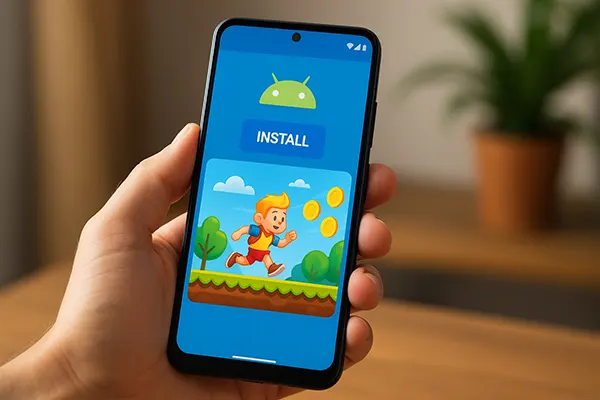
Testing Android Apps Without Installation: How Google Play Instant Works in 2025
In February 2025, Android app testing has reached a new level of convenience thanks to the evolution of Google Play Instant. This technology enables users to try applications without installing them, a function that not only enhances user engagement but also optimises app discovery and reduces friction in the installation journey. Let’s explore how this system functions today, what benefits it offers developers and users, and how it has evolved to meet the current demands of the mobile ecosystem.
Google Play Instant in 2025: Key Advancements
Google Play Instant now supports a wider range of applications, including feature-rich games and enterprise tools. Developers are no longer restricted to stripped-down versions of their apps. Thanks to Android App Bundles and advancements in dynamic delivery, instant experiences are more representative of the full version, allowing users to make informed decisions before downloading.
Performance enhancements introduced over the past year have also significantly reduced the launch time for Instant Apps. In 2025, many apps open in less than 4 seconds, even on mid-range devices. This seamless experience keeps users engaged and lowers the bounce rate.
From a user perspective, access points have multiplied. Besides trying apps directly from the Play Store, users now encounter Instant Apps across Google Search, YouTube ads, social media previews, and even messaging apps—broadening the discovery landscape exponentially.
How Instant Apps Work Technically
Instant Apps are powered by modularisation. Developers split their app into smaller, independent modules. When a user interacts with the Instant version, only the essential modules are delivered to their device, which ensures faster loading and minimal data usage.
This process relies on the Android App Bundle structure, which helps Google Play serve only the code and resources required for the user’s device configuration. Developers define entry points for Instant functionality in their manifest files, allowing partial app experiences without compromising performance or stability.
Moreover, Play Core libraries have been upgraded to support real-time user analytics for Instant sessions. Developers can now assess user behaviour before installation, making it easier to iterate and optimise the conversion funnel.
Benefits for Developers and Marketers
One of the most notable benefits is improved conversion. According to Google’s 2025 developer trends report, Instant App users are 45% more likely to install the full app compared to users who encounter a standard ad. This behaviour is particularly prominent in the mobile gaming sector, where trying a game before installing it improves retention rates.
In-app analytics for Instant experiences now include custom event tracking, giving developers insights into user flows, drop-off points, and feature popularity. This data fuels better user interface design and smarter feature prioritisation for future updates.
Marketers have also embraced Instant Apps in UA (User Acquisition) strategies. The ability to embed try-now features into ad campaigns allows users to engage with apps contextually—boosting both engagement and install rates across multiple channels.
Monetisation and User Retention Strategies
To support monetisation, Google has expanded support for ad SDKs within Instant Apps. This means rewarded ads, interstitials, and even some in-app purchases are possible during the trial experience. Developers are encouraged to strike a balance, ensuring ads don’t overwhelm the short Instant session.
User retention strategies have evolved as well. After completing a session, users are prompted with tailored install CTAs (Call To Actions), often including dynamic install offers or limited-time bonuses. This technique has proven effective in increasing first-day retention by over 20%.
Additionally, integration with Google Play Points and loyalty systems now continues seamlessly from Instant to full versions, maintaining user progress and rewards, which encourages longer-term app engagement.

Implementation Considerations and Best Practices
To get started with Google Play Instant in 2025, developers must use Android Studio Hedgehog or later, which includes built-in support for instant testing and modular project templates. This significantly reduces development overhead and accelerates the rollout process.
Developers should follow best practices by minimising app size, reducing unnecessary permissions, and designing intuitive user journeys. Instant Apps should deliver immediate value to users, avoiding login gates or feature restrictions that may deter exploration.
Testing remains a crucial part of the development process. With the new Firebase App Quality Insights, developers can simulate various device conditions and test network behaviour to ensure a consistent and reliable Instant App experience across global markets.
Future Trends and Challenges
While Instant Apps have gained significant traction, challenges remain—particularly around maintaining performance on legacy devices and managing fragmented user experiences between Instant and installed versions. Google has responded with guidelines for state sharing and lightweight data persistence between versions.
Security is another focus area. In 2025, Google Play Protect includes real-time scans of Instant App modules, ensuring no malicious code is served during preview sessions. This builds trust with users and maintains the integrity of the Instant ecosystem.
Looking ahead, Google is exploring server-streamed Instant Apps, allowing even richer app previews through cloud execution. Though still in beta, this could become a game-changer for high-performance apps and games with complex logic or graphical requirements.



